Whenever Shark Week rolls around, people start wondering about the plausibility of keeping one in their home aquariums.
Good thing freshwater sharks offer a few manageable sizes.
And if you’re looking to avoid aggressive behaviors, the roseline shark (Sahyadria denisonii) is perfect.
As with the other “shark” members of the Cyprinidae family, roselines aren’t actually sharks.
That shows in their other common names: red-line torpedo barb, Denison barb, Miss Kerala, and Chorai Kanni (a common name in India, meaning “bleeding eyes”).
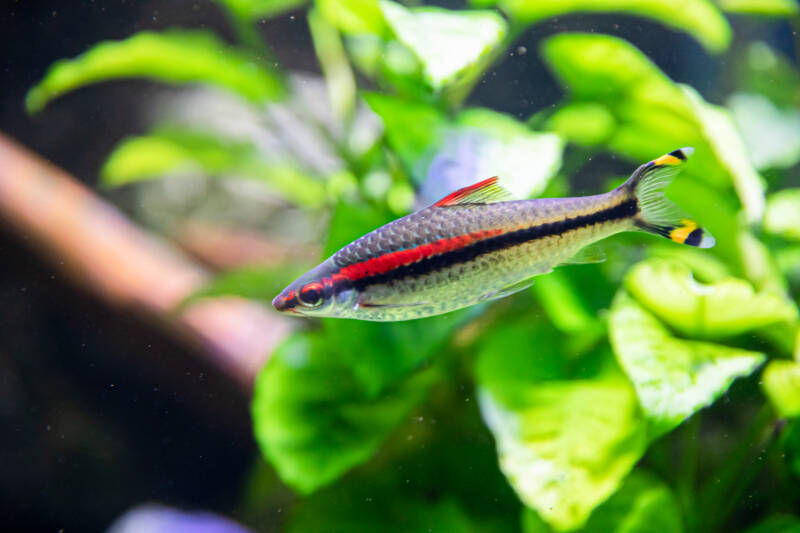
They earn their way into the “shark” category with a streamlined torpedo shape and a triangular dorsal fin.
You even get the expected base shade of silver to their scales. But then they have a vibrant streak of red along the lateral line (starting behind the eye) and green on the head.
Their pops of color don’t stop there, either. The caudal fin sports stripes of black and yellow, extending to the tips.
And while genuine sharks maintain fierce reputations, roselines have a peaceful temperament, appealing to aquarists of any level.
Of course, you should expect a few challenges with a creature with the word “shark” in its name.
Because while saltwater species are content to cruise the ocean solo, roseline sharks are schooling fish.
And if you don’t get the numbers JUST RIGHT, you could have problems.
At a Glance
| Min tank size: | 55 gal (208 l) |
| School size: | 6 at a minimum; 12 is better |
| Temperature: | 60-77°F (15.5-25°C) |
| Lifespan: | up to 5 years |
| Size: | 6 inches (15 cm) |
| pH: | 6.6-7.8 |
| Hardness: | 5-25 dH |
| Ammonia: | 0 ppm |
| Nitrite: | 0 ppm |
| Nitrate: | <10 ppm |
[toc]
In the Wild
As you might guess with names like Miss Kerala and Chorai Kanni, roseline sharks come from India – the Western Ghats (mountain ranges), to be specific.
They stay within four regions: the Achankovil, Cheenkanni Puzha, and Chaliyar rivers, and near Mundakayam town.
They stay in the fastest part of the streams and rivers in the area, congregating in massive shoals in waters with high oxygen levels.
You’ll find sandy stream beds dotted with rocks, with plenty of vegetation to provide safety and cover from predators and the overhead sun.
The bright colors of the roseline shark – and their dynamic nature – make them popular aquarium acquisitions.
A little TOO popular. Combined with deforestation in the Western Ghats, numbers started plummeting.
The IUCN Red List currently lists roselines as endangered, and they’ve marked the population as decreasing.
It’s an alarming trend. Most of the fish available come from commercial fisheries.
They remain popular, but it’s essential to consider environmental impact when choosing them.
Size: Your Average Shark
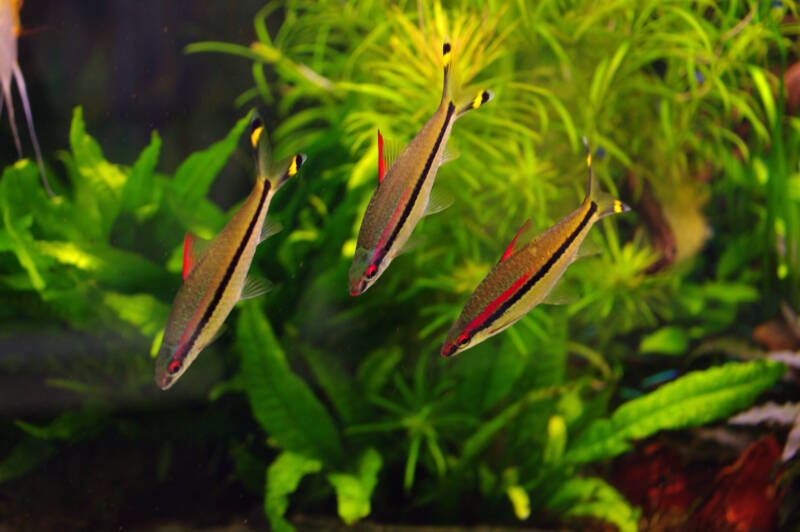
Colorful freshwater fish are always popular with aquarists. And the easier it is to spot those colors, the better.
This is one more reason roseline sharks top the list for people.
They grow to six inches (15 cm) in length as adults.
You don’t need to worry about an extended growth period, either. If you purchase juveniles, you can expect a steady rate of growth.
Of course, that means you’ll need to have the tank prepared to handle the adult size of your red-line torpedo barbs.
Lifespan
Loss of habitat plays a big part in the disappearance of roseline sharks from their native regions.
With nowhere to reproduce, they can’t restore their declining population.
Something they’d typically find easy, as they usually only live for around five years.
As long as you keep their water quality in tip-top shape, you can expect the same kind of lifespan.
Of course, you’ll also need to source a high-quality diet and provide comfortable living spaces. It isn’t difficult, but it requires some homework and thought.
Behavior
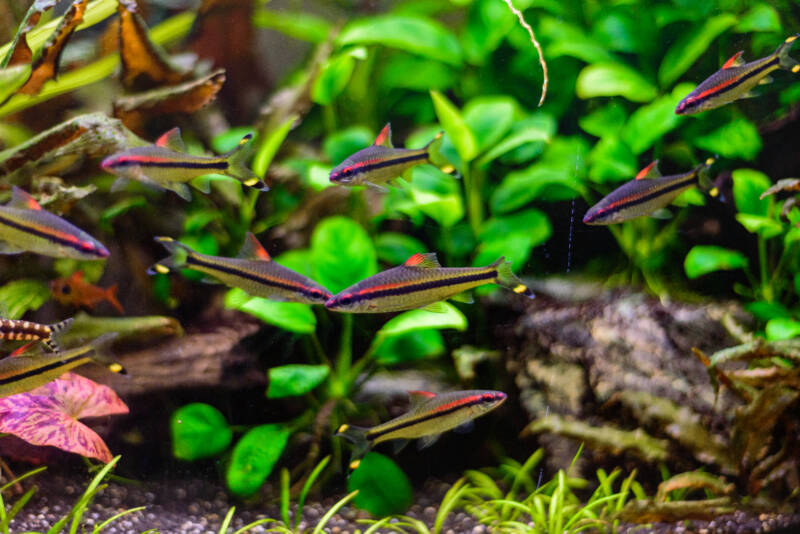
In the wild, roseline sharks congregate in schools. They’re peaceful, active fish that prefer the company of their own kind.
And if you want to prevent potential problems from erupting in your tank, you’ll need to keep that in mind.
Social interaction is critical with this species. A lone roseline shark can quickly become aggressive.
You may see your fish inciting fights over available food and swimming space – even in a spacious aquarium. It’s the shoal that reinforces good behavior.
The smallest school you should consider is six fish.
But if you want to ensure a healthy population for your Denison barbs?
You need to bump up to twelve (or even more!) fish. This allows for the unison swimming that creates the flashing colors aquarists crave.
Even in a proper shoal, you may still encounter some intermittent bad behaviors.
Male roselines put on displays for dominance within the group. You may even see the displays progress to sparring.
Injuries are rare, and the duels are short-lived. But it’s something to watch for.
And if you don’t give proper concern to your tank setup, a healthy school can still lead to problems.
Roseline sharks that feel crowded will turn aggressive towards other fish in the aquarium.
Not to mention the stress they’ll feel, packed in like sardines.
Tank Setup
So how to gauge the tank size to fit such an impressive school? Keep in mind the adult size of the roseline shark.
If you’re going to go for the minimum end of the school scale, you shouldn’t go any smaller than 55 gallons (208 l). And don’t go shorter than 4 feet (1.2 m).
However, you’re planning to upgrade the shoal as they settle in, right?
As such, you want to add 6-10 gallons (23-38 l) for each additional barb. This will allow every fish room to swim and feel comfortable.
When crowded into tight spaces, you run the risk of injury (not to mention problems with aggression).
Roseline sharks can startle easily. And when they panic, they may press against the sides of the glass. Depending on how frightened they get, they may even slam into it.
And that brings up the concern of a tight-fitting lid. If your torpedo barbs don’t flee into the glass, they may leap for the surface.
As adults, they have enough strength to push a light cover OFF (that “torpedo” name isn’t a joke). Then you have sharks carpet surfing on the floor.
Roseline sharks hang out in swift currents in the wild. You want to balance that desire with the swimming ability of your other fish.
The best way to do so is with powerheads near the surface, angled down. This will set up a pleasant current that dissipates along the bottom.
Water Conditions
As hardy fish, roselines can tolerate temperature ranges anywhere from 60-77°F (15.5-25°C).
But if you want to keep them healthy for the longest time possible, try to keep your water in the middle of that range.
They prefer a neutral pH, but you can get away with slightly acidic waters.
Anything within the range of 6.6-7.8 will suffice nicely. And your hardness level gives you plenty of room from 5-25 dH.
Those primary water conditions suit almost any colorful freshwater aquarium.
It’s when you look at your water quality that things get tricky. Roseline sharks have NO tolerance for ammonia or nitrites.
And while roselines can tolerate a nitrate of 5 ppm, you don’t want to go above 10 ppm. If you do, you’ll see their colors start to fade.
Decorating the Roseline Tank
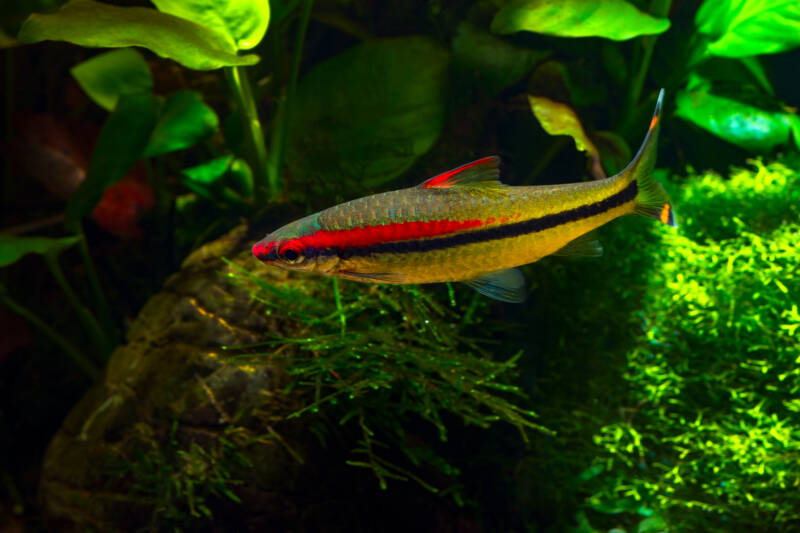
The biggest concern for roseline sharks is room to swim.
They’re active fish that spend the majority of their time exploring the open areas of the tank. Overcrowding can lead to problems with your shoal.
At the same time, if you don’t attempt to mimic their natural habitat, stress will set in.
Any time these fish get stressed, they lose their color. It’s a handy indicator of problems but NOT something you want to see in your tank.
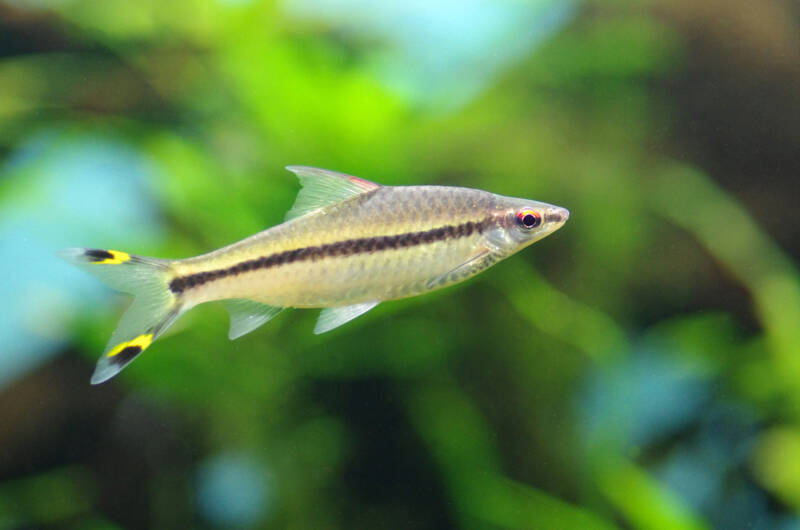
Roselines come from sandy streams and rivers. And you can use sand or fine gravel as your substrate.
Rocks and pebbles scattered along the bottom will provide a more natural appearance.
You don’t need too much as red-line torpedo barbs prefer the middle and upper water column.
Vegetation plays an essential role for roseline sharks. They use plants to hide when startled and whenever they feel overwhelmed.
Keeping your greenery to the back and sides of the tank will leave room for swimming while soothing that stressful worry.
While roselines ARE omnivores, they don’t usually nibble on the décor. But you still want to take care of securing your plant choices.
As active swimmers, these sharks often uproot plants as the school darts around the tank.
Get these plants bedded down tight:
- Anubias
- Bacopa
- Cabomba
- Hornwort
- Java fern
- Pennywort
- Vallisneria.
You also want to add a few other hiding spots. Driftwood and natural cave rocks will do the trick nicely.
Just make sure you’re leaving room in the open. And take the adult size of your roseline sharks into account when you choose your pieces.
Roseline Sharks in Communities
Nothing beats an impressive school of roseline sharks, flanking and diving in formation.
Plenty of aquarists choose to keep this species on its own.
But with their peaceful temperament (when kept in ideal conditions), they also do equally well in community tanks.
Tank Mates
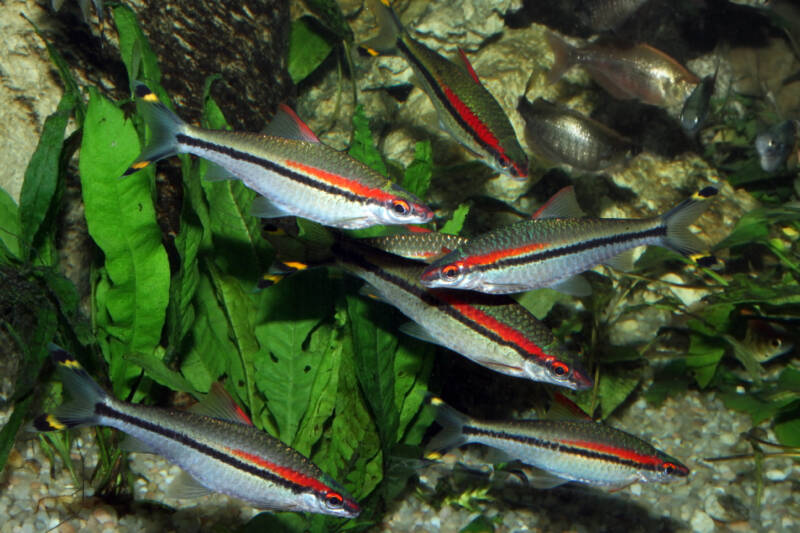
Once you’ve sorted the tank size to erase the worst of the aggression problems, you have quite a few choices for tank mates for your roselines.
They get along well with like-minded fish, especially those that can keep up with them in terms of speed:
- Apistogramma
- Bolivian rams
- Bristlenose plecos
- Celestial pearl danios
- Cherry barbs
- Corydoras
- Golden dwarf cichlid
- Harlequin rasboras
- Kribensis
- Leopard danios
- Odessa barbs
- Rainbowfish
- Red-tailed rasboras
- Rosy barbs
- Tetras (Larger members of the group)
- Tiger barbs
- Yoyo loaches
- Zebra danios
- Zebra loaches
Incompatible Species
While roselines don’t target smaller fish – for bullying or snacking – you probably want to avoid them due to potential injuries.
Roseline sharks are FAST. As they dart around the tank, they can bump into tiny fish.
The same goes for fish that prefer to take a more leisurely approach to swimming (such as most fancy goldfish).
The high speeds may prompt stress or even starvation.
Slow-swimmers can’t compete with the swift roselines for food, and they may retreat into hiding too often.
And even the best tank setup won’t curb the roselines’ habit of nipping.
They can’t resist trailing or delicate fins. So you want to skip mixing them with bettas or guppies.
The risk of fin and tail rot is too high (to say nothing of the stress).
Food and Diet
Roseline sharks are omnivores. In the wild, their menus consist of algae and small invertebrates.
The balance of the two is what keeps their colors so vibrant.
Not to mention it supplies their demanding metabolic needs. And it’s your job to do the same.
They’ll happily consume commercial foods without a problem – so long as they sink. They’re not surface feeders.
So skip flakes. And try to find options with carotenoids in the ingredients. These are natural pigments that produce red and orange colors (so, helping that red line stay bright).
Plants and phytoplankton tend to have the highest concentrations of carotenoids. So look for algae wafers and spirulina when you check for your food choices.
Popular sinking pellets that roseline sharks enjoy include Bug Bites and Repashy Spawn and Grow.
Quality proteins will boost their colors, too. You can use live, freeze-dried, or frozen options equally well.
And they’re not picky about their favorites:
- Blackworms
- Bloodworms
- Brine shrimp
- Glassworms
- Mysis shrimp
- Tubifex worms
- White worms.
Due to their active nature, you want to feed your roseline sharks twice a day.
But avoid dawn and dusk. This is when the fish get feisty.
If you introduce food into the mix, they can turn more aggressive. Try to pick alternative times (if you can).
Breeding Roseline Sharks: Not For the Standard Home Aquarium
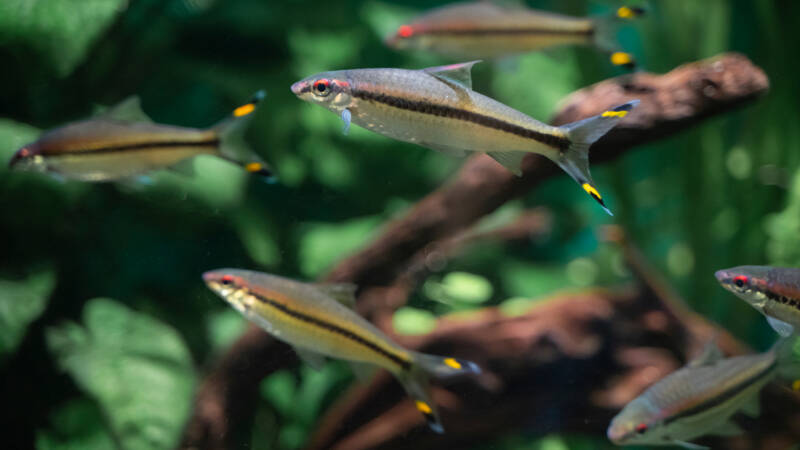
For the most part, the breeding of roseline sharks remains confined to commercial operations and the use of hormones.
The fisheries utilize LARGE and elaborate setups that produce the fish sold to fish stores around the world.
However, that doesn’t mean you’re out of luck.
A few random cases of breeding in the home aquarium HAVE surfaced. They’re not common situations, though.
And trying to pinpoint the precise methods? That’s tricky. You may be in for a lot of trial and error.
Male or Female?
Sorting out male and female roselines gets tricky. If you try to look at color, you won’t see a difference – for the most part.
Both sexes have the same vibrant patterns. But, occasionally, females will look duller when you compare the two side-by-side.
Otherwise, you need to look at the size. Male roseline sharks are slightly smaller than females.
It’s not a dramatic difference, though. And if you don’t have a large school (which you’ll need if you’re hoping to breed them), you may not know for sure.
A Numbers Game
When it comes to roselines spawning in home aquariums, the reported cases happened by accident.
The aquarists woke up to find tiny roseline shark fry hiding out in the plants.
But they had one thing in common: schools of MORE than 15 fish.
Some reports noted a change in the dorsal fin of the adults before the suspected spawning event.
Rather than the usual red band at the front, they saw the fin turn blue.
This may be part of a courtship display for the species. It certainly signaled appropriate conditions.
Without a healthy shoal, it appears that a significant “cue” simply doesn’t happen.
And other cues seem to relate to pH and water hardness.
Reports suggested that gradually lowering pH to 5.7 and hardness to 2-3dH appeared to do the trick. You can do this with fresh driftwood.
The eggs have shown up in Java moss, but no one knows if roseline sharks will accept other greenery.
The parents don’t show any sign of guarding their eggs.
And the risk of adults eating the egg (or fry)? It’s significant. You may want to watch and remove the eggs.
Unfortunately, figuring out how to care for roseline fry isn’t widely known.
Based on their reported size, you can probably get away with feeding them baby brine shrimp.
As this species grows quickly, it won’t take them long to get large enough to join the community tank.
Roseline Shark Health
Roseline sharks have a hardy reputation. And since you can see their colors fade, you have a reliable indicator of when things start to go wrong.
But stress in these peaceful sharks isn’t a good way to find out your water quality has slipped.
Unfortunately, as stress sets in, so does the risk for disease.
And roselines have a higher sensitivity to ich than a lot of other species.
This presents a particular problem due to their tight social network. Because as soon as one starts showing those spots, others aren’t far behind.
Roseline Sharks: Are They For You?
Due to the declining numbers of roseline sharks in the wild, their price can get pretty expensive.
You’ll see them listed anywhere from $10-$30, depending on size. And, unfortunately, even with captive breeding facilities, that price is likely to continue to climb.
It’s something you should consider when you decide you want to bring home a school of roselines.
They ARE an endangered species. Should you contribute to the continued decline? Or is it more responsible choosing another, healthier species?
A Barb By Any Other Name
Maybe roseline sharks aren’t actual sharks. They’re not even as fearsome as some freshwater sharks.
But their bright colors and stunning schools brighten aquariums.
And while you may elect not to bring one home, you can always advocate for the species and its endangered status.
Do you have roseline sharks? What size is the school in your tank?
Have you seen any eggs or fry yet?
Share your stories and questions with us here!
